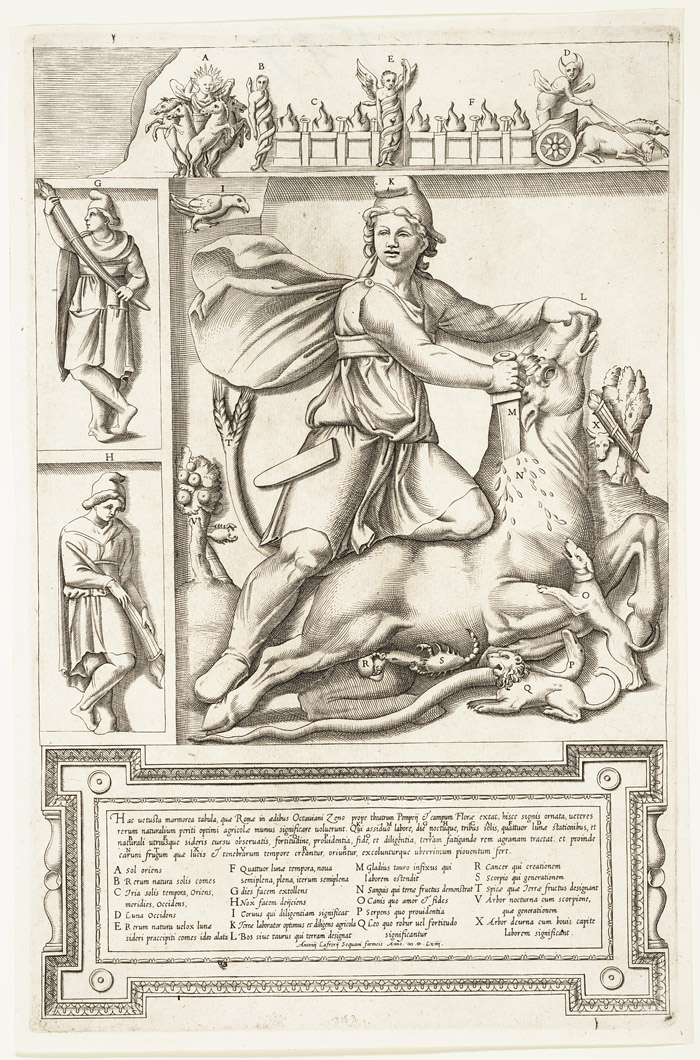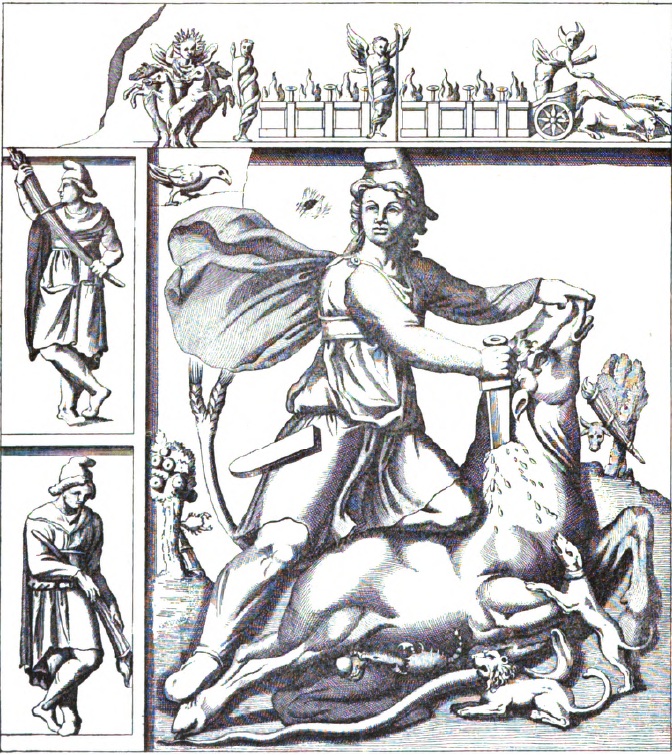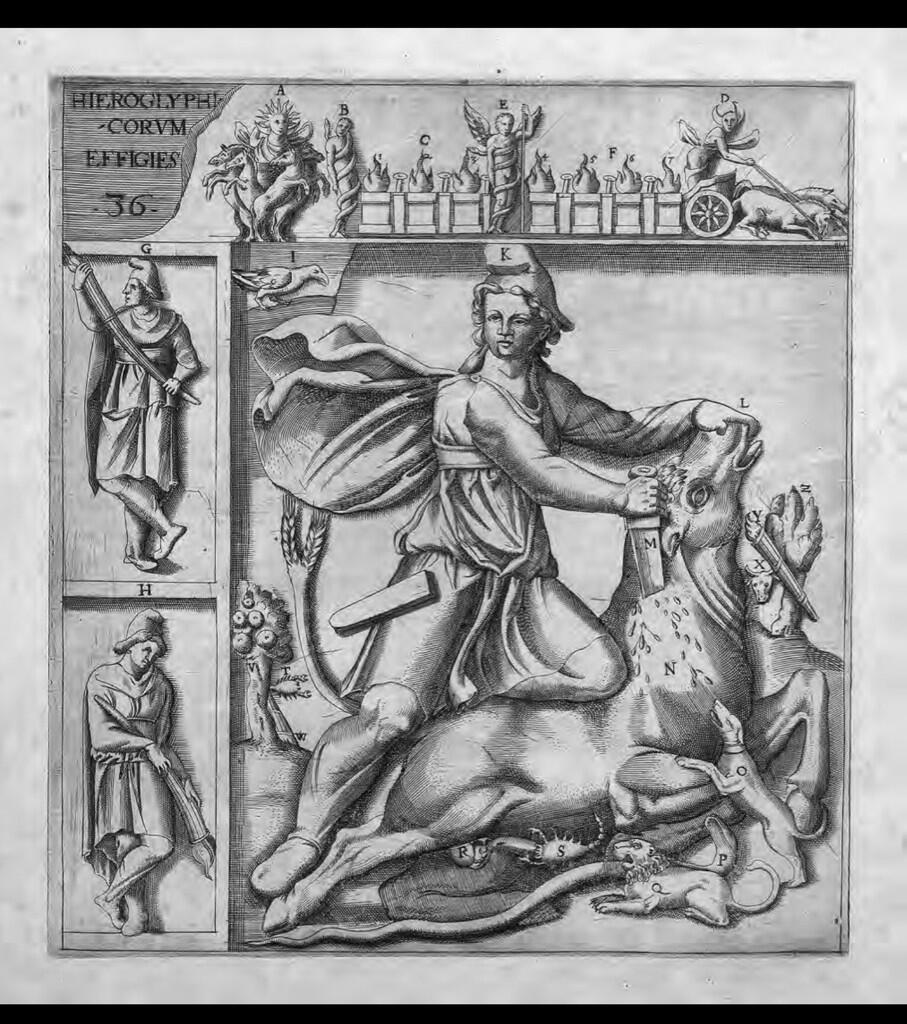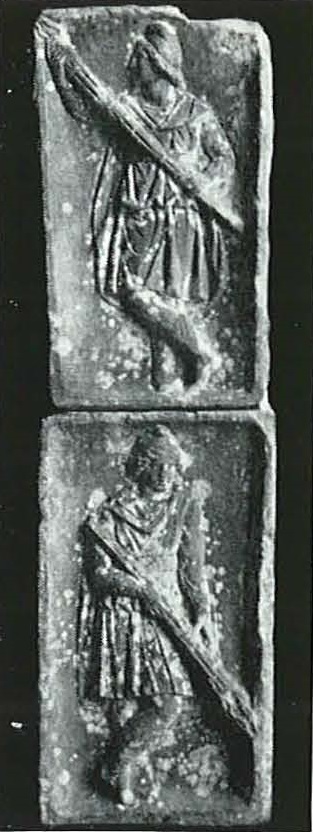
CIMRM 335 - Tauroctony of Ottavio Zeno. Rome, now lost.

An old but extremely well-known relief, now lost. TMMM indicates that it was of terracotta, but in fact it must have been of marble.
First published by Lafreri, Speculum romanae magnificentiae, 1564. A drawing of the monument may be found in the papers of Pighius, held at Berlin, Ms. lat. A. 61 f. The TMMM figure 63 is a photo-reduction of Montfaucon's drawing.
Chicago entry
Caption: Hac vetusta marmorea tabula, quae Romae in aedibus Octaviani Zeno prope theatrum Pompeii I campum Florae extat, hisce signis ornata, veteres, veteres rerum naturalium periti optimi agricolae munus significare volerunt. Qui assiduo labore, die noctuque, tribus solis, quattuor lunae stationibus, et naturali utrusque sideris cursu observatis, fortitudine, providentia, fide, et diligentia, terram fatigando rem agranam tractat et proinde carum frugum quae lucis I tenebrarum tempore creantur, oriuntur, excolunturque uberrimum pioventum fert.
Translation: By this ancient marble picture, decorated with these images, which exists in the house of Octavian Zeno in the Floran field near the theatre of Pompeii the Great, ancient farmers, the most skilled and noblest, wished to show the gifts of natural things. He who manages the farmed property by overcoming the land, through constant labor, night and day, through the three watches of the sun and four of the moon, through fortitude, providence, faith, and diligence and hence he bears the most fertile and beloved of the fruits which are created, cultivated, and born at once into the light from the darkness.
Signature: Antonii Lafrerii Sequani formeis Anno. DLXIII
Location (creation): Rome
Measurements: 41.0 x 27.3 cm plate mark on 40.2 x 26.0 cm
References: L-A v.2, p.352, ad a. 1564
Techniques: Engraving
CIMRM entry
335. Marble relief, formerly in the house of Ottavio Zeno near the Theatre of Pompejus. Lost.
Jahn, Codex Pighianus, 190 No. 71; Lafreri, Spec. Magn., gives a fig.; Camerarius, Re rust.:26ff and fig.; Marliani, Topogr., 152; H. Ferrutius (Ferveci), who completed Marliani's work, speaks about a marble relief and not of a terracotta one. Franz Cumont communicated us, that already Michaelis draw his attention to the fact, that the oldest descriptions are mostly speaking of a marble relief and that the possessor was not called Ottavio Zeni but Ottavio Zeno. Beger, Spicilegium, III, 97, XXI; de Montfaucon, Ant. Expl., I (2),373f. and Pl. 215, 4; Hieroglyphicorum collectanea ex veteribus et neotericis descripta, Johannis Pierii libris addita, Colonia Agrippinae 1631, t. 24f; Cartari, Im., 294; Gronovius, Gemmae et Sculpturae, I fig. 1; Turre, Mon. Vet. Antii, 161; Hyde, Vet. Pers. Hist., 113; v. Dale, Dissertationes2, 17 (fig.); Dupuis, Origine, Pl. 17, 4; Drummond, Oed. Jud., fig. 13, 2; Romanelli, Isola Capri, fig.; Zoega, Abh., 150 No. 26; Seel, Mithrasgeh., 238ff and Taf. IX; Müller, Mithras, fig. 1; Eichhorn, de deo Sole, fig. 5; Hammer, Mithriaca, 78ff with Pl. 11; Lajard, Intr., Pl. LXXXIX; Culte de Venus, 212 and Pl. XVI; Basrelief Transsylv., Pl. VI; MMM 11 23lff No. 70 with fig. 63; Pesce in Bull. SRAA 1939, 246 and fig. 11; Vermaseren, Mithrasdienst in Rome, 56ff. See figs. 92 and 93.
Mithras slaying the bull, whose tail is ending in two ears. The god wears a broad belt around his chest and he carries the dagger-sheath at his side. The dog with collar near the wound; a serpent creeps over the ground; the scorpion grasps the genitals; a lion lies on the ground; the raven is perched above Mithras' flying cloak. On either side of this scene a tree is represented. Behind the bull a fruitbearing tree. A scorpion is creeping up against it; at the foot of the trnnk a torch is sticking in the ground. At the other side a tree with heavy foliage, at which an upraised torch as well as a bull's head are attached.
On the upper rim of the relief seven burning altars alternate with six daggers in holders. In the centre of it stands a naked figure with two wings on the shoulders (Aion). With his upraised l.h. he holds a staff, entwined four times by a serpent. On the left side next to the altars a similar figure is standing, but without wings and staff.
In the left corner a representation of Sol in radiate crown. He stands in a quadriga with rearing horses. In the r. corner stands Luna, bending forward in a biga, which is in descending direction. Behind the goddess' head a crescent.
Colini, Storia Celio, 48 likes to identify "a Mithras-relief and two small marble tablets with torchbearers", with our monument. Aldrovandi, Le Statue di Roma, 280 (quoted by Colini, 236 n. 3) describes this relief as following: "una tavola marmorea dove di mezzo rilievo è un huomo che amazza un toro et un cane morde il toro, un serpe li punge un ginocchio, uno scorpione i testicoli; sono poi a piè di un albero uno scorpione, una face, e la testa di un toro; dalla parte di dietro è una colomba, di sopra è il sole e la luna con molti altri vaghi ornamenti; è una delle belle sculpture in marmo che in tutta Roma si vegga".
The relief is said to have been "in casa di Ascanio Magarozzi presso Torre de 'Conti' " and toorigihate from "sua vigna sul monte Celio presso a S. Stefano".
The description by Aldrovandi does indeed show a striking resembiance with the monument of Ottavio Zeno, who therefore must have possessed it later on. We believe that Colini's identification is correct and this supplies us at the same time with some data about the "due tavolette marmoree" with the representation of the torchbearers, about whom Aldrovandi speaks and of whom we see the representations next to the drawings of this Mithras-relief. They have come from the Caelius and were also in the possession of Ascanio Magarozzi. We believe to have found these reliefs again in the Louvre Museum, where they had been walled into a base of a statue of Pan (Inv. No. 287). When they were fixed, is not exactly known, but they were in the Louvre at the time of Clarac (Mus. Sculpt., II Pl. 184 No. 506; cf. Zoega, Abh., 148 No. 12; MMM II 482 No. 58ter and figs. 416-417). By the kind permission of Pierre Devambez, Keeper of the Louvre, we had a photograph of the two torchbearers made in the same formation in which they are represented on the drawings. They are two marble reliefs (H. 0.33-0.35 Br. 0.18-0.20 D.0.06-0.08) with the torchbearers in Eastern attire and cross-legged. They hold the torch with both hands. Froehner, Sculpt. du Louvre, No. 431 identifies them already with the left part of the relief of Ottavio Zeno and the photograph confirms this.
The height of the relief with Mithras slaying the bull must have been 0.68; all the monuments together might have belonged to one and the same Mithraeum.
| Tweet |


